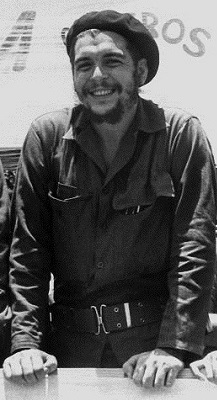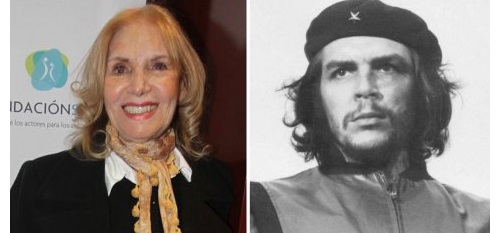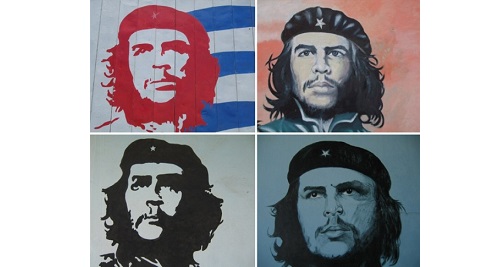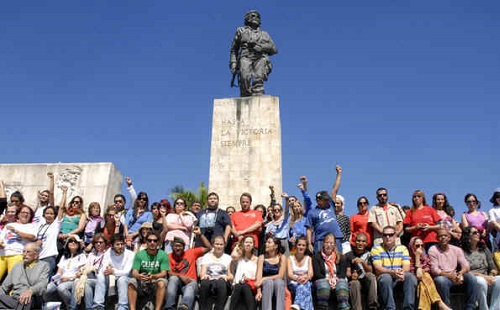|
~ Ernesto Che Guevara
~ Galéria
~ Oldal
~ Bejelentkezés
~ Vissza a Főoldalra
Ernesto Che Guevara, az argentin származású forradalmár, miniszter, gerillavezér és író, Buenos Aires-ben szerzett orvosi diplomát, majd a kubai forradalom során jelentős szerepet játszott a szigetország felszabadításában és újjáépítésében. A kubai gazdaság talpraállításáért dolgozott, küzdött az oktatás és az egészségügy fejlesztéséért, az írástudatlanság és a faji előítéletek felszámolásáért. Saját példájával népszerűsítette az önkéntes munkát. Kongóban és Bolíviában is harcolt - harminckilenc éves volt, amikor az amerikai-bolíviai csapatok csapdába ejtették és kivégezték.
| | |
|

| | |
|
|
|
Haydée Padilla és Che Guevara
|

Haydée Padilla arról beszélt, hogyan találkozott Che Guevara-val
Az argentín színésznő visszaemlékezett: “Nagyon fiatalok voltunk, a szüleim béreltek egy farmot Mendoza-ban és a Guevara család volt a szomszédunk. A bátyáim és én átmentünk táncolni a Guevara-házba és ott volt egy jóképű, nagyon rokonszenves fiú. 14 éves voltam, ő 20. Kedves volt és azt mondta nekem: “Táncoljunk, Buenos Aires-i kislány.”
Akkoriban a Colón-i tánciskolába jártam és azt feleltem: “Hogy lehet, hogy nem tudsz táncolni?”
Elmondta a fiúnak, hogy táncosnő szeretne lenni, a fiú pedig a nagy terveiről mesélt neki: “Sok dolgot fogok látni, orvos leszek és változásokat hozok.”
A színésznő folytatta: “Ez megijesztett és azt mondtam neki: “Nem tudsz táncolni, de változásokat akarsz hozni.” Azután körbenéztem és megláttam egy másik fiút, akiből később Mendoza kormányzója lett, és együtt táncoltunk.”
Padilla elmondta, hogy a fiatal Ernesto nagyon édesen és ravaszkásan nézett rá és ez neki tetszett. Sosem felejtette el a fiút és azt mondja, hogy olyan személyisége volt, amit mélyen tisztelt. “Kíváncsi vagyok, hogyan alakult volna az életem, ha elfogadtam volna a felkérését.”
Forrás
|
|
Haydée Padilla talked about her memories when she met Che Guevara
The Argentinian actress remembered: “We were very young, my parents hired a farm in Mendoza and the Guevara family was our neighbour. My brothers and I went to dance in the house of the Guevara family and there was a handsome, very engaging boy. I was 14 years old and he was 20. He was lovely and he told me: “Let’s dance, little girl from Buenos Aires.”
I went to the dance school of Colón and I told him: “How is that you cannot dance?”
She told him that she wanted to be a dancer and he spoke about his big plans: “I am going to see a lot of things, I am going to be a doctor, I am going to bring changes.”
She continued: “This frightened me, and I said: “You can’t dance, you are going to bring changes.” Then I looked around and I saw another boy who later became the governor of Mendoza and we danced together.”
Padilla says that the young Ernesto had a really sweet and sly glimpse and she liked it. She could never forget him and she says that he had a personality that she deeply respected. “I am curious how much my life would have changed if I had accepted his proposal.”
Source
|
|
|


| 2014.01.29. 10:10, Aleida |
La piedra | The stone
|
|
|
When Che Guevara was told (while being in the Congo in 1965) that his beloved mother had died, he wrote a short story about his feelings. It was titled La piedra (The stone) - referring to the keychain with a stone that his mother had given him a long ago.
The story can be found in the original Spanish on the internet, but I haven't found an English translation and unfortunately my Spanish knowledge is still not good enough for translating the text by myself. But thanks for Micaela, an amazing girl from Tumblr - now the story can be read in English too.
THE STONE
He told me how they should say these things to a strong man, to a responsible man, and I was grateful. He didn’t lie worry or pain and I tried to not to show neither the one nor the other. It was so simple!
Besides we had to wait the confirmation to be officially sad. I wondered if you could mourn a little. No, it shouldn’t be, because the boss is impersonal; it’s not that you are denying his right to feel, simply, he must not show his own feelings, his soldiers’, perhaps.
- It was a family friend, they phoned him telling that she was really severe, but I went out that day.
-Severe, deathly?
- Yes.
- Don’t stop letting me know about everything.
As soon as I’ll know, but there is no hope. I think.
[Read more]
|
|
|


| 2014.01.28. 08:00, Aleida |
Pletykák | Rumours
|
Néhány spanyol nyelvű internetes cikk állítása szerint Che Guevara-nak házasságon kívüli viszonya volt Havannában, 1963-ban az akkor húszéves, újságírónak készülő Lidia (Lilia) Rosa Lópezzel.
A lány meglátogatta egy barátnőjét, aki éppen egy könyvet olvasott, ami felkeltette az éppen arra járó Che figyelmét. Lidia flörtölni kezdett vele. Nem sokkal később Che egy könyvet vitt a barátnőnek és egy másik könyvet Lidiának (Edmundo de Amicis-tól a Corazon-t). Ezután rövid viszony kezdődött, aminek váratlanul vége szakadt néhány hónappal később, amikor Che-nek gyakran kellett hosszabb külföldi utakra mennie. Soha többé nem találkoztak.
[Tovább olvasom]
|
|
Some Spanish-speaking online articles claim that Che Guevara had an extramarital affair in Havana with Lidia (Lilia) Rosa López, a 20-year-old journalism student in 1963.
She visited a friend at work who was reading a book that caught Che's attention who also happened to be there. Lidia started flirting with him. Next time Che brought a book for her friend and another book (Corazon by Edmundo de Amicis) for Lidia. Then they started a short relationship that ended within a few months when Che often had to go abroad for long journeys. They never met again.
[Read more]
|
|
|


| 2014.01.27. 08:00, Aleida |
Che Guevara és a szenzációhajhász cikkek
|

Az utóbbi hónapokban több olyan cikket is találtam az interneten, amelyben tíz vagy éppen ötven "fontos tényt" közöltek Che Guevara-ról - természetesen több pontatlansággal is, a szenzációkeltés érdekében - Che halála óta népszerűbb dolog róla ostobaságokat és hazugságokat írni, mint az igazságot.
A tegnap talált angol nyelvű cikket nem fordítom le - akit nagyon érdekel, elolvashatja [itt]. Most csupán a tévedéseket emelem ki, ahogyan azt a cikk alatti hozzászólásban is közöltem a szerzővel.
"Che-nek öt gyermeke volt - és nem hat. A cikk szerzője kicsit többet gyakorolhatná a matekot, mivel, 1 + 4 = 5. Che az allergiákra összpontosított, amikor az orvosi egyetemen tanult és miután megkapta a diplomáját és Mexikóban dolgozott. Fiazalabb korában szeretett azzal dicsekedni, hogy ritkán fürdik és cseréli a ruháit, de kétlem, hogy a forradalom győzelme után bűzlött volna. Valószínűleg a felesége vagy a több ezer ember, akivel találkozott, szóvá tette volna, nem? Korda híres fényképe nem Che temetésén készült - hanem 1960. március 5-én, a havannai kikötőben felrobbant francia hajó, a La Coubre áldozatainak emlékére rendezett szertartáson. És végül: Che teljes neve Ernesto Guevara de la Serna - mivel a spanyol nyelvű emberek mindkét szülőjük családnevét viselik. Ernesto Guevara Lynch Che édesapjának a neve."
|
|
In the previous months I met several articles on the internet that were shared ten or even fifty "important facts" about Che Guevara - of course with several inaccuracies for the sake of sensation - since Che's death it has been more popular to write lies and bullshit than the truth about him.
You can read the original article if you want to [here]. Here you can check out my reply that I wrote in a comment under the article.
"Let's correct some mistakes. Che had five children - and not six. The writer of the article should practise a little more Maths as 1 + 4 = 5. He concentrated on allergies when he studied medicine and after receiving his degree and working in Mexico. He liked boasting about having a bath and changing his clothes rarely when he was young but I don't think he smelled after the victory of the Revolution. Possibly his wife or those thousands of people he met would have made a comment about it, correct? Korda's famous photo was taken not on Che's memorial service (wtf?) - it was taken on 5th March 1960 on the memorial service of the victims who died when the French ship La Coubre exploded in the Havana harbour. And for the last: Che's full name is Ernesto Guevara de la Serna - as Spanish-speaking people wear the surnames of their parents. Ernesto Guevara Lynch is the full name of Che's father."
|
|
|


| 2014.01.25. 07:00, Aleida |
A dél-amerikai Che-brigád tiszteletadása Santa Clara-ban
|

Január 23-án Santa Clara városában a Latin-Amerikai Szolidaritás Brigád több, mint kétszáz, többségében fiatal tagja rótta le tiszteletét Che Guevara előtt az emlékére épített komplexumnál. Az önkéntesek (akik között tanárok, egészségügyi dolgozók, szociális munkások és diákok találhatóak) Argentínából, Chiléből, Brazíliából és Uruguayból érkeztek és munkájukkal a Kuba iránti szolidaritásukat fejezik ki.
Miután megtekintették a Che fotóit és személyes tárgyait bemutató múzeumi kiállítást, valamint a legendás parancsnok és elesett bajtársainak hamvait tartalmazó sírhelyet, ellátogattak az emlékhelyre, ahol a kisiklatott páncélvonatot nézhették meg - a Santa Clara-i csata mellett ez is Che Guevara nevéhez fűződik.
A brigád több másik kubai városba is ellátogat, hogy tovább mélyítsék a tudásukat a kubai életről, gazdaságról és kultúráról.
Forrás
|
|
On 23rd January in Santa Clara more than 200 members of the Latin-American Brigade of Solidarity with Cuba paid tribute to Comandante Che Guevara at the memorial complex, built for his memory. The volunteers are mainly young people, teachers, medical professionals, social workers and students, and they come from Argentina, Chile, Brasil and Uruguay.
After looking at the exhibition of photos and personal objects of Che Guevara in the museum, and the memorial site where the legendary commander and his fallen comrades were buried, they visited the Tren Blindado - the derailed armour train that was stopped and derailed by Che - his other important victory besides the Battle of Santa Clara.
The brigade is going to visit other Cuban cities as well, in order to get to know the Cuban life, economy and culture more.
Source
|
|
|


| 2014.01.24. 13:35, Aleida |
| | |
|
|
|
~ Ernesto Che Guevara
~ Gallery
~ Site
~ Log in
~ Back to the Main page
Ernesto Che Guevara, the Argentine-born revolutionary, minister, guerrilla leader and writer, received his medical degree in Buenos Aires, then played an essential part in the Cuban Revolution in liberating and rebuilding the country. He did his best to set up the Cuban economy, fought for the improvement of the education and the health system, the elimination of illiteracy and racial prejudice. He promoted voluntary work by his own example. He fought in the Congo and in Bolivia - he was thirty-nine years old, when he was trapped and executed by the joint American-Bolivian forces.
| | |
|
|

